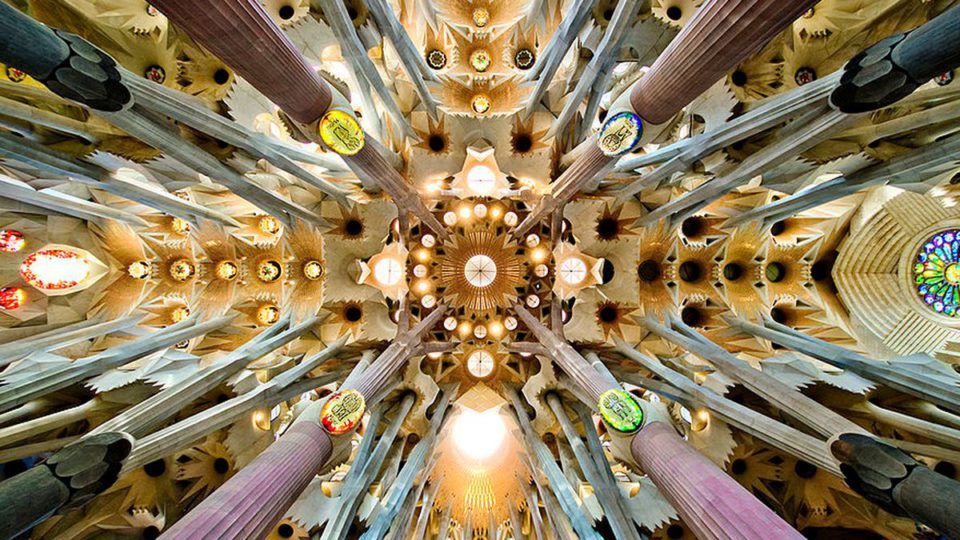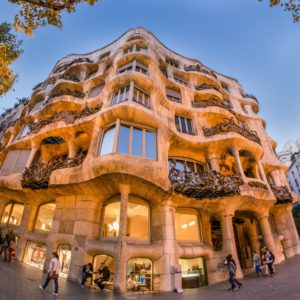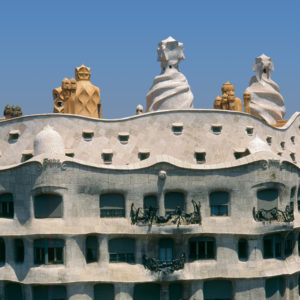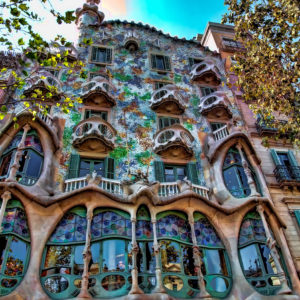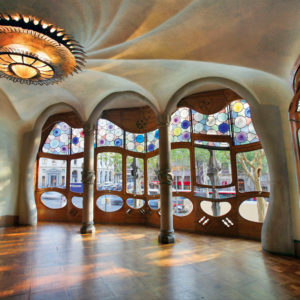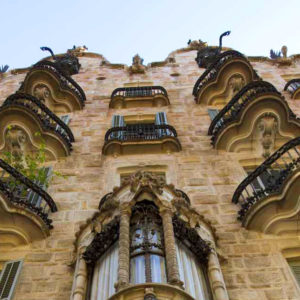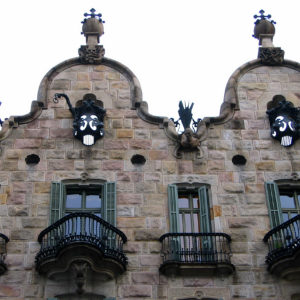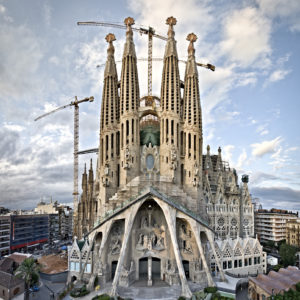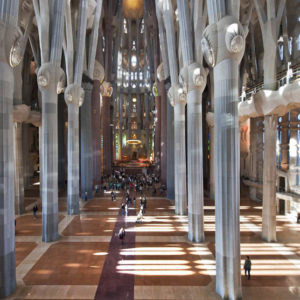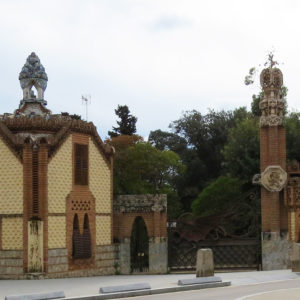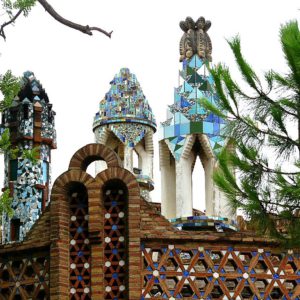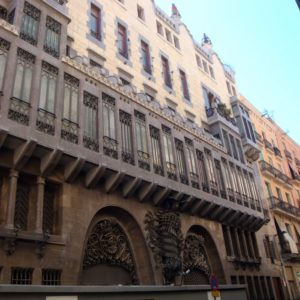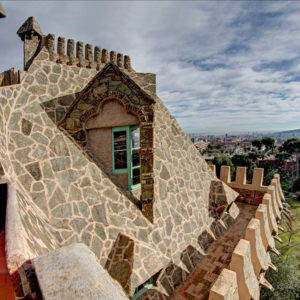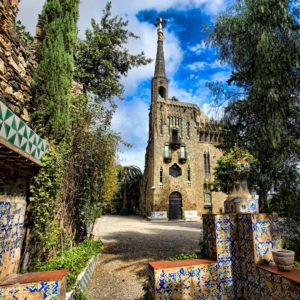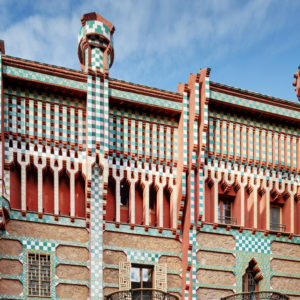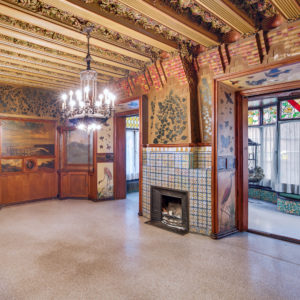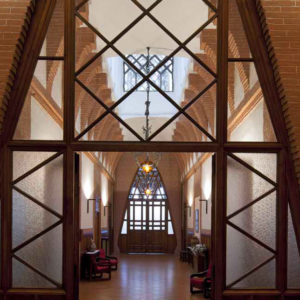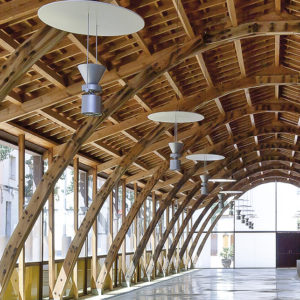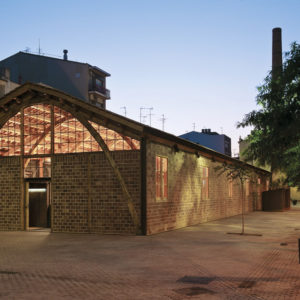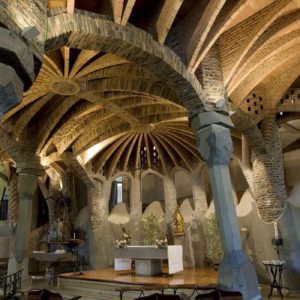Antoni Gaudi’s footprints in Catalonia, especially in Barcelona
The works of Antoni Gaudi have achieved wide international fame, spread over the years. Innumerable studies are dedicated to their understanding.
His works are admired by professionals and by the public in general: the Sagrada Familia is currently one of the most visited monuments in Spain. The RVD Media Group offers you in this article a list of his most emblematic and popular buildings appreciated nationally and internationally. All of them are perfect locations for your next audiovisual projects.
The Milà House, La Pedrera
Gaudi’s Casa Milà, popularly called La Pedrera, is a modernist building built between 1906 and 1910 in the Ensanche district, Barcelona. It is a mythical location in Barcelona for your photographic shooting or audiovisual production.
Architecturally, it is considered as an innovation due to the use of a structure of walls and floors free of load walls. Most railings have a rather abstract shape, although there are some specific details such as a pigeon, a theater mask, a six-pointed star, various flowers and the Catalan shield.
The interior of Casa Milà is designed in a functional way for a fluid interaction between the different parts of the building. For this, the ground floor has two entrances with vestibules that connect the exterior and the interior, and that, connect with the two patios of lights, encourage also the internal traffic between the two zones of the building.
The Batlló House
Casa Batlló is Antoni Gaudi’s greatest representative of Catalan modernism. It is an integral remodeling of a previously existing building on the site, a work of Emilio Sala Cortés.
The Casa Batlló is a reflection of the artistic fullness of Gaudi: it belongs to his naturalist stage (first decade of the 20th century), a period in which he perfected his personal style, inspired by the organic forms of nature, for which he put in practice a whole series of new structural solutions.
The remodeling so radical and at the same time so brilliant in the use of colors and shapes never seen in a façade, quickly made it to an icon of the new Barcelona. You will not miss this icon of modernism in your next audiovisual project!
Casa Calvet
At the end of the 19th century, the right side of the Eixample became a booming neighborhood, occupied mostly by the growing textile industrialists. One of them, Pere Mártir Calvet, entrusted Antoni Gaudi to build a traditional rental house, his business should be in the underground and the main floor should be used as a family home.
Although it seems to be one of the architect’s most conservative and less daring constructions, numerous ornamental details and the distribution of spaces, such as the patio of lights, reveal the architect’s great mark. A discovery to locate a photographic shooting or an elegant and sophisticated audiovisual production.
The Holy Family
The Sagrada Familia is the most known and the most characteristic monument of Barcelona. It is the maximum exponent of the modernist architecture created by Gaudi, thousands of tourists come every day to visit the curious but unfinished temple.
The grace and uniqueness of the building can be found in the radical transformation that the artist made of the initial neo-Gothic project, turning it into a monumental temple of gigantic dimensions. If you want to use this location for your audiovisual project, it will be difficult for you to be alone.
The basilica has 3 symbolic facades:
- Façade of the birth: dedicated to the birth of Christ, profusely decorated and full of live.
- Façade of the passion: Something more austere and simplified, aims to reflect the suffering of Jesus during the Crucifixion.
- Façade of the Glory: Much larger and monumental, represents death, the Last Judgment, Glory and hell.
The Güell Pavilions
The pavilions of Finca Güell are a series of buildings located in the neighborhood of Pedralbes, in Barcelona, built by Gaudi between 1883 and 1887. Another fascinating location for your audiovisual production or photographic shooting.
The pavilions are a small masterpiece, where Gaudi repeated the aesthetic of his early works, introducing at the same time elements that characterized his stage of maturity, such as arches, parabolic vaults and hyperbolic domes.
The Park Güell
Park Güell is one of the most emblematic works of Antoni Gaudi, built between 1900 and 1914. It is a public park with gardens and architectural elements located in the upper part of the city of Barcelona.
Always faithful to his principles, Gaudi uses in an admirable way the materials that the place offers him. Adapted to the difficult topography of the mountain he build a system of streets and viaducts to reach the houses, making the relevant excavations and getting a civil work with minimal impact and optimal landscape adaption.
The remarkable dimensions of the whole and the great slope necessitated him to create different accesses. Gaudi projected in his personal style two magnificent pavilions and a large and ornate garden staircase, which the visitor leads to a large arcade, the Hypostyle Hall.
On this covered space he built the great esplanade, an authentic viewpoint over the city, bordered on its perimeter by banks of a wavy profile, made with prefabricated concrete feet covered with mosaics done using broken pieces of ceramic. Views, buildings and a large space, superb to locate your next audiovisual project.
The Palau Güell
The Palau Güell is one of the first important commissions Gaudi received at the beginning of his career. This peculiar urban palace is an extension of a family house on the Rambla de Barcelona.
The Palau Güell (1886-1890) is a magnificent example of domestic architecture in the context of modernism. It was the home of the Güell – Lopez family until they moved to Park Güell.
Gaudi knew how to design a functional palace adapted to the needs of the private life of the family and to the intense social and cultural life that it was going to welcome. Luxury and glamour for your audiovisual production or photo shooting.
The Bellesguard Tower
Gaudi’s Bellesguard Tower is one of his most singular and symbolic works. It was built between 1900 and 1909 and is one of the few buildings created by the Catalan genius that is still inhabited by its original owners.
Although its official name is Casa Figueras, everyone knows this construction as Torre Bellesguard because of the beautiful views that could be seen from it. An ideal location for an audiovisual project.
This work of the neo-Gothic period of Gaudi is located at the foot of the Collserola mountain range, its construction is in stone and brick, with a square basis, an area of 900 m2 and an apex on the four cardinal points.
Casa Vicens
It is located on a narrow street in the Gracia neighborhood and it was Gaudi’s first major project. When it was built, between 1883 and 1888, Gracia was still an independent part of Barcelona. This first work of the architect is recently restored and is also an ideal location for your photographic shooting or audiovisual production.
The building belongs to the oriental period of the Catalan architect, a period in which he builds buildings with a marked oriental taste. The abundant use of colorful ceramics in its façade is one of its essential features.
Teresianes School
Its construction coincided with the celebration of the Universal Exhibition of Barcelona. Gaudi was already a coveted architect who a few years before was started with the construction of the crypt of the Sagrada Familia.
Despite being involved in large-scale projects, his interest in work with religious aspects made him accept more modest works such as the convent and college of Las Teresianas, in Sant Gervasi de Cassoles. A little known and a more modest work with Gaudi touches for your audiovisual project.
Nau Gaudí
La Nau Gaudi is the only Gaudi building that has not been commissioned by the bourgeoisie or the church. It is considered as a key work because it is the first of Gaudi that initiated one of the most genuine characteristics of his work: the use of arches as supporting elements.
This cotton bleaching plant stands out for the importance of experimenting with the parabolic arches, which allowed him to cover a diaphanous space of almost 600 square meters without using columns or walls. Since 2010 the building is used as the headquarters of the Bassat collection in Mataró. A location outside of Barcelona for your most industrial audiovisual project.
Crypt of Colonia Güell
It is built between 1908 and 1915 and it is the first building in which Antoni Gaudi used all his architectural innovations. It belongs to the naturalist stage of the Catalan architect, in which he perfects his personal style and is inspired by the organic forms of nature.
In addition to the architectural part, Gaudi also designed all the interior furniture, in which stand out the benches with a recliner placed in a circular way around the main altar. Also noteworthy are the large windows with glasses of flowers in the form of flower petals or butterfly wings. Both the interior as the exterior is perfect for your photo shootings and audiovisual productions.
If you want support to find the location that your next projects need, do not hesitate to contact us. Tell us your needs and we will take care of everything. We leave you a link to our portfolio and services so you can think about your next production.
More Information about RVD Media Group.
RVD Media Group is a content creation agency with creative and digital marketing solutions. We bet on great ideas and create strategic moves. We can help you with all types of content, both photographic and audiovisual. Don`t hesitate to contact us.




